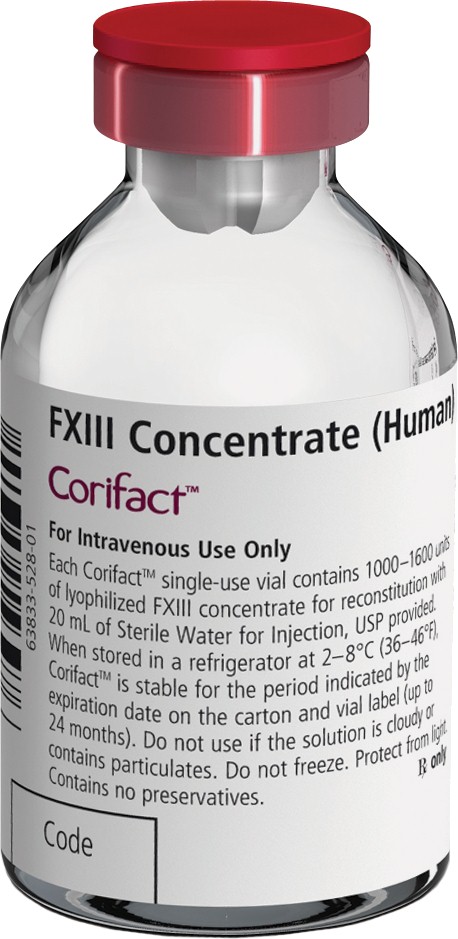Convenient Dosing and Administration for Prophylactic and Perioperative Management
Concentrated formula allows for low infusion volumes, which may help reduce preparation and infusion times.
- CORIFACT dosing, duration of dosing, and frequency of administration in adults and children should be individualized based on body weight, laboratory values, and the patient's clinical condition.
Prophylactic Management
- INITIAL DOSE: 40 International Units (IU)/kg body weight intravenously at a rate not to exceed 4 mL per minute
- SUBSEQUENT DOSING: Every 28 days based on monitoring of trough FXIII activity levels
- Adjust dose +/- 5 IU per kg to maintain 5% to 20% trough level of FXIII activity as provided in the example below.
- Based on pharmacokinetics, dose adjustments may be needed for patients <16 years of age.
Dose Adjustment Using the Berichrom Activity Assay
| FXIII Activity Trough Level (%) |
Dosage Change |
| One trough level of <5% |
Increase by 5 IU per kg |
| Trough level of 5% to 20% |
No change |
| Two trough levels of >20% |
Decrease by 5 IU per kg |
| One trough level of >25% |
Decrease by 5 IU per kg |
Perioperative Management
Dosing should be individualized based on the patient's FXIII activity level, type of surgery, and clinical response.
- Monitor patient's FXIII activity levels during and after surgery.
Dose Adjustment for Perioperative Management
| Time since last dose |
Dose |
| Within 7 days |
Additional dose may not be needed |
| 8 - 21 days |
Additional, partial, or full dose may be needed based on FXIII activity level |
| 21 - 28 days |
Full prophylactic dose |
Administration
- Single-use vial with actual potency (units) allows for reconstitution in minutes.5
- Mix2Vial® transfer unit offers needle-free reconstitution.
- Minimizes risk of injury and shortens prep time
- Administer at a rate not exceeding 4 mL per minute.
Long-term stability optimizes storage, access, and inventory management

- Stable for up to 6 months at room temperature (not to exceed 25°C [77°F]) and up to 36 months when refrigerated (2°C–8°C [36°F–46°F])
- Extended shelf life affords easy storage and access
Important Safety Information
CORIFACT®, FXIII Concentrate (Human), is indicated for routine prophylactic treatment and perioperative management of surgical bleeding in adult and pediatric patients with congenital Factor XIII deficiency. CORIFACT must be administered intravenously.
CORIFACT is contraindicated in individuals with known anaphylactic or severe systemic reactions to human plasma-derived products.
Hypersensitivity reactions may occur with CORIFACT. If there are signs of anaphylaxis or hypersensitivity reactions (including urticaria, rash, tightness of the chest, wheezing, and hypotension), immediately discontinue administration and institute appropriate treatment.
Inhibitory antibodies to FXIII have been detected in patients receiving CORIFACT. Monitor the patient’s trough FXIII activity level during treatment. If expected plasma FXIII activity levels are not attained or breakthrough bleeding occurs, perform an assay measuring FXIII inhibitory antibody concentrations.
Thromboembolic complications have been reported with CORIFACT; monitor patients with known risk factors for thrombotic events.
CORIFACT is derived from human blood. The risk of transmission of infectious agents, including viruses and, theoretically, the Creutzfeldt-Jakob disease (CJD) agent and its variant (vCJD), cannot be completely eliminated.
The most common adverse reactions reported in clinical trials (frequency >1%) following treatment with CORIFACT were joint inflammation, hypersensitivity, rash, pruritus; hematoma, arthralgia, headache, elevated thrombin-anti-thrombin levels, and increased blood lactate dehydrogenase. Serious adverse reactions included hypersensitivity, acute ischemia, and neutralizing antibodies against FXIII.
Please see full prescribing information for CORIFACT.
To report SUSPECTED ADVERSE REACTIONS, contact the CSL Behring Pharmacovigilance Department at 1-866-915-6958 or FDA at 1-800-FDA-1088 or
www.fda.gov/medwatch.